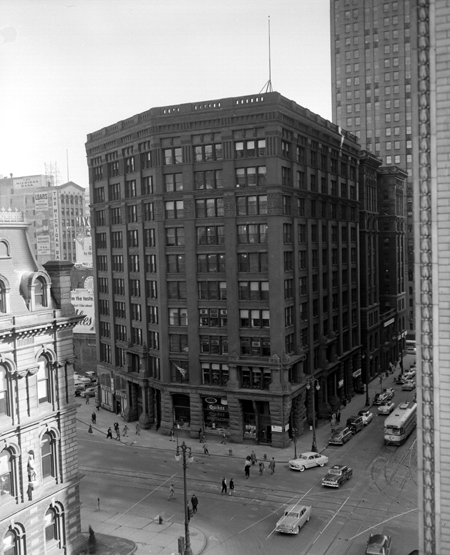A fire that began with the burning ashes of a tobacco pipe destroyed Detroit on a windy day in 1805, setting the stage for decades of real estate transactions. Then, as now, emergency management of the flattened city was delegated to outsiders. The United States Congress determined that Gen. William Hull, appointed governor of the Michigan Territory by President Thomas Jefferson, and a board of judges, including Augustus Woodward, would run things. “This aggregation was regarded by the (600) residents as a sort of foreign satrapy that had been imposed upon them,” historian George Catlin wrote. The governor and judges ruled for 20 years.
As part of the rebuilding process, a 10,000-acre federal land grant was conveyed to the city, which speculators all but inhaled. As Woodward designed a street plan patterned after Washington, D.C., so-called park lots of five and 10 acres began to change hands. At auction in 1809, Solomon Sibley bought 13 such lots, paying a princely $335.75. A decade later, Sibley bought more lots, prompting the Revolutionary War veteran, Maj. Thomas Rowland, to tell Charles Trowbridge, who later became mayor of Detroit, “A fool and his money are soon parted.”
The crucial deal of the early 19th century came in 1816 when Gov. Lewis Cass acquired 500 acres from William Macomb for $12,000. After holding the property for 19 years, Cass sold off the riverfront portion, where Cobo Center and Joe Louis Arena now stand, to a syndicate paying $100,000. Days later he auctioned other portions of the farm, netting an additional $68,000.
“Buying and selling is the order of the day,” the Journal and Courier reported on June 10, 1835. “Our city is filled with speculators, who are all on tiptoe.” Six months later, some $350,000 worth of transactions was recorded. In this go-go time, the Cass farm syndicate included such notables as Trowbridge, along with Elon Farnsworth, Edmund Brush, and Oliver Newberry, all of whom left their names in the city. After the Civil War, particularly in the 1870s and 1880s, real estate entered another boom phase, and Griswold Street overflowed with dealers. Clarence Burton, a lawyer who did title work, figured transactions rose from $9.8 million in 1883 to $20.7 million by 1890.
By most accounts, the Hannan Real Estate Exchange pulled off the biggest deals. William Hannan, a former University of Michigan track star and football running back, found himself swinging a $1-million purchase of the Hammond Building, the tallest building (at 10 stories) in the state when it opened in 1890 (it was replaced by the National Bank of Detroit building, since renamed Chase Tower, in 1956). Another $125,000 dispatched the property on Woodward Avenue where J.L. Hudson built a department store.
Hannan stuck his bushy mustache into everything, dominating the rental market, developing subdivisions such as Medbury and Baldwin Park, and investing in partnerships. He clamorously promoted individual home ownership. True to his principles, in 1902 he built the Pasadena Apartment Building, an 11-story structure at 2170 East Jefferson, and lived there with his well-to-do tenants. The yellow brick and limestone building remains in operation.
After Hannan died on Christmas Eve in 1917, historian Silas Farmer wrote that the city’s earlier developers delivered value. “They have enriched themselves, and promoted the interests of the city by their business sagacity, and it is largely owing to their efforts that so great a proportion of our inhabitants are freeholders.” If only the same results can be achieved this time around. db












